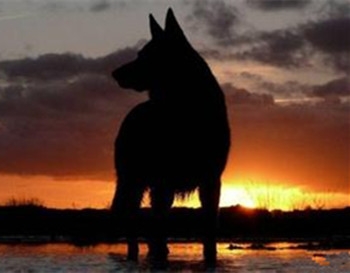
and may trace their ancestry all the way back to the first dogs to enter North America. The Carolina dogs are pack animals with a strick hierarchy topped by an alpha male. Like most wild dogs, they hunt in groups. But many of the kills they make are small. Rabbits and small rodents make up a large part of their diet in what can become a collective feeding frenzy. At the end of the ice age, these dogs' ancestors also had access to other sources of food. They may have hung around the camps of early native people, scavenging the scraps.
它們的祖先是第一批來(lái)到北美大陸的犬。卡羅來(lái)納犬屬于馱獸的一種,它們的等級(jí)制度十分嚴(yán)格,公犬則處于頂層。和其他野生犬一樣,它們成群捕食。但是他們大多數(shù)的捕食對(duì)象體型較小。兔子和小型嚙齒動(dòng)物是他們的主要食物,不過(guò)它們捕食的數(shù)量很多。在冰河時(shí)代末期,這些犬種的祖先同樣找到了其他的食物來(lái)源。他們可能徘徊在早期土著居民的住所邊,吃著人類的殘羹剩飯。
But although they lived on the fringes of human society, the early wild dogs were certainly not pets. Exactly when they arrived in North America is still uncertain. But it's likely that they slipped in after the extinction of the ice age beasts during a time of massive change.
但是盡管它們生活在人類社會(huì)的邊緣,早期的野犬也絕對(duì)不是寵物犬。它們具體何時(shí)來(lái)到北美大陸還無(wú)法探尋。但是,它們很有可能是在北美大陸發(fā)生巨大轉(zhuǎn)變,許多大型動(dòng)物滅亡后來(lái)到的北美大陸。
Eventually the continent became more settled. Over the next few thousand years, people adapted to the many regions of the continent and their varying lifestyles were shaped by the landscape they lived in.
終于,大陸的面貌變得更加定型。在接下來(lái)的幾千年里,人類適應(yīng)了大陸的很多地區(qū),而他們多種的生活方式則是由他們居住的居住環(huán)境決定的。
Then more than 14,000 years after the first people set foot in North America, another wave of immigrants brought changes that would have a dramatic impact on the landscape and wildlife of the new world.
在14000多年前,當(dāng)?shù)谝慌祟愄ぷ惚泵篮螅硪慌泼裾邘?lái)的巨大影響將會(huì)波及整個(gè)新世界的地貌以及野生生物。
英文文本來(lái)自普特英語(yǔ),譯文屬可可原創(chuàng),僅供學(xué)習(xí)交流使用,未經(jīng)許可不得轉(zhuǎn)載。











